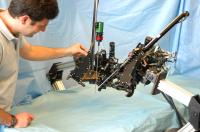
|
 |
Bringing space age to surgery equipment, procedures
Aug 22, 2006, 20:18, Reviewed by: Dr. Rashmi Yadav
|
|
"Surgical training is modeled like a medieval apprenticeship: You go to med school and then you have a residency where you hang out with a surgeon and watch, and they let you help out a little bit and you try more and more parts of the operation,"
|
By US Department of Defense Congressionally Directed Medical Research Programs,
Though robots were once the stuff of Star Wars and The Jetsons, commercially available systems have made robotic surgeries common in hospitals. Located just feet away from the surgeon, the systems are minimally invasive and offer surgeons better dexterity.
Department of Defense-funded researchers want to take that capability to the next level so surgeries can commence on battlefields with the surgeon's work being done by a robot that's miles away and connected by communication links.
"There is a large community that is envisioning a robot that is deployable in an armored vehicle, much closer to combat, where an expert surgeon can remotely work on the patient very quickly after an injury is sustained," said Dr. Blake Hannaford, a professor of electrical engineering and adjunct professor in bioengineering and mechanical engineering at the University of Washington. "The kind of focus, as I understand it, is stopping arterial bleeding that's not amenable to a tourniquet � and stabilizing that so that a Soldier can be transported for regular care."
 |
| Dr. Blake Hannaford's lab is developing robotic arms for remote telesurgery at the University of Washington. |
Hannaford and his team have created a surgical robot that works on a patient's abdomen. It has two arms, and a motorized carriage on the operating table lets the arms move anywhere on the table.
"It's very position-able to any part of the body," he said, adding that this may possibly allow the robot be used on arms and legs.
Hannaford's research endeavors were funded, in part, by a grant from the DoD's Peer Reviewed Medical Research Program. Congress created the program in 1999 to promote research in health issues the military faces. Since its inception through 2005, the program has spent almost $300 million to fund nearly 200 projects in a range of medical topics, including combat casualty care and technology and infectious disease research.
Along with Hannaford, Drs. Jacob Rosen, Mika Sinanan and Richard Satava are also co-investigators on the grant.
"We're established in this area because of this grant," he said. "There's a good chance we wouldn't be in this field if not for this grant."
Hannaford didn't set out to create a robot. His initial grant, from the Defense Advanced Research Projects Agency, was to measure surgeons' movements and develop a way to evaluate their skills statistically with software.
"Surgical training is modeled like a medieval apprenticeship: You go to med school and then you have a residency where you hang out with a surgeon and watch, and they let you help out a little bit and you try more and more parts of the operation," he said. "It isn't formalized. There aren't official milestones for each year."
After completing that research, Hannaford took his data on surgeon movement and crafted his robot. Renowned telesurgeon Dr. Tim Broderick put the robot through its paces June 3-11 in Simi Valley, California via a communications link that was bounced off an unmanned aerial vehicle, Broderick operated Hannaford's robot first from the valley and then from Seattle.
The desert experiment was a success, said Dr. Gerry Moses of the Telemedicine and Advanced Technology Research Center, which also funds part of Hannaford's research. "It encountered some challenges with the communications link, but there were no considerable technical challenges. In fact, this gave us a roadmap of what we need to work on next," he said.
Not having surgical expertise in remote areas is not just a military issue, Hannaford said. The University of Washington in Seattle is the only medical school in five states and has patients who hail from Alaska, Montana, Idaho and Wyoming.
"There are patients in Alaska who are 1,700 miles from Seattle. If their little clinic can't handle the problem, they come all the way to Seattle. Some patients might be resistant to the idea (of robotic telesurgery) at first, but surgeons have found many patients receptive to the technology, and if they can be taken care of in their own community, there's a benefit," he said.
For example, a surgeon in Canada, Dr. Mehran Anvari, has conducted more than two dozen robotic telesurgeries via the Canadian telephone system on patients who were 250 miles away. Robotic telesurgery may also bring specialized surgical skills to military field hospitals where they may be in short supply.
Neither Hannaford nor Moses say that robotic telesurgery will be on the battlefield next month or next year but they do believe that with hard work it will be there in the not-too-distant future.
"We're not talking about something that's going to be immediately available, but if we don't do this research now, we will not have the option of having surgical intervention remotely or robotically (on the battlefield)," Moses said. 
- University of Washington
cdmrp.army.mil
The Peer Reviewed Medical Research Program is one of the Congressionally Directed Medical Research Programs directed by Col. Janet R. Harris. The Peer Reviewed Medical Research Program is an administrative funding agent for the U.S. Army Medical Research and Materiel Command. The command is the Army's medical materiel developer, with lead agency responsibility for medical research, development and acquisition. The command's expertise in these critical areas helps establish and maintain the capabilities required by the Army to fight and win on the battlefield.
|
For any corrections of factual information, to contact the editors or to send
any medical news or health news press releases, use
feedback form
Top of Page
|
|
|
|